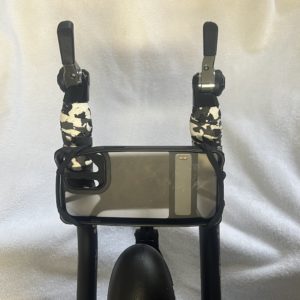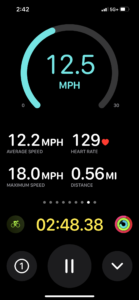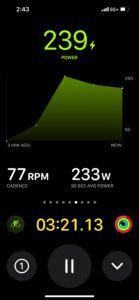Most of our riding is done indoors and in the virtual world of Watopia (Zwift). Outdoor rides have been reserved for free form exploring. Indoors the ZwiftHub smart trainer serves as a power meter and cadence sensor, but outdoors riding was just by feel.
This made sense since outdoor riding is only an occasional hobby and the cost to get a dedicated bike computer and power meter have not been worth the payoff. Then, with the new update of watchOS 10 Apple made it easy to integrate a power meter with a watch and you can use an iPhone as a bike computer head unit.
Using Power Pedals for Cycling with Apple Watch and iPhone
Pairing a power meter to Apple Watch is dead simple. Once you open up the Settings>Bluetooth the watch auto senses power meter that is in pairing mode.
We picked up a pair of Garmin Rally power pedals (which can be found here on Amazon) and had them installed and setup within 10 minutes of opening the box.
Compared to the issues of trying to pair multiple devices to Zwift, having everything integrated through the Apple system reduces issues with setup. Similarly, when starting an outdoor ride on our watch, the pedals are automatically pulled in each and every ride so there is power data included.
For anyone who has had issues pairing and syncing a power meter, and started a workout only to find out that the power meter did not start or data has dropped out, this is a major benefit. No more messing with pairing and maintaining the setup, instead you can just focus on riding.

The other major benefit of using a single system is that it lets you reuse devices that you already have. We prefer to keep a phone with us on outdoor rides. Instead of also carrying a dedicated cycling computer, which often costs $500 or more, you can pickup an inexpensive phone mount for the bike that turns your iPhone into a full fledged cycling computer. The Garmin to iPhone compatible mount shown above is available on Amazon and has yet to drop a phone on even the roughest roads.
Using iPhone as A Cycling Computer
Apple is still new to the game for making everything natively work as a cycling computer, so some of the screens available are not as customizable as leaders like Garmin. Still, once you have everything paired up, the displays become automatic.
By starting an ‘Outdoor Ride’ on your Apple Watch activity tracker it will magically make seeing all the information an option on your paired phone. By default there are 7-8 screens that display standard information that is useful for executing workouts or maintaining a good pace on long rides.
Shown below are the two screens we prefer to focus on the most. While there are others that have more detailed information, for the most part our rides are either focused on maintaining a specific heart rate (while seeing how far we have gone) or on a specific power output.

Above is the default iPhone screen for speed, distance, and heart rate. Again there is no customization required to get this working. As soon as you have migrated to the latest OS these displays pop up when doing workouts. No more having to drop $500 on a computer, learn all of the buttons and switches, go through the pairing issues, and customizing your screen.

Of course the pieces that are missing from the displays are the more custom cycling options including navigation as well as full workout power details. Still, when you know that your head unit is a smart phone it is easy to load up full maps apps and look at them for turn by turn directions.
Take Aways from Using Apple Products for a Bike Computer
Overall the option to use Apple products as your primary cycling computer has become a real option with the latest updates to include power meters. Our takeaways after a few months of using the Garmin Rally Power Meter Pedals, Apple Watch Ultra, and iPhone are:
- Setup and maintaining pairing is easier than other brands. Apple is great at maintaining bluetooth connections.
- Power Meter pedals make it easy to swap across bikes without much maintenance. Pedal power meters are costly but overall this saves time and money.
- The iPhone workout screens while riding are somewhat limited and harder to customize than the leading bike computers. Still, you can get 95% of the displays you need so for most riders the useful functions are front and center.
This setup has proved useful over a number of outdoor rides and made it less intimidating than buying a full dedicated Garmin device (which would have cost an additional $300 at least). We will continue to update this review as we learn more about the setup.